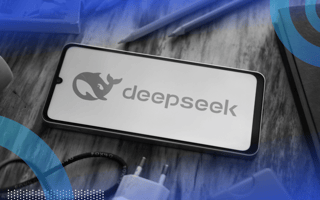In just nine months, a Chinese startup has disrupted the global artificial intelligence (AI) landscape with its groundbreaking model, R1. Developed by DeepSeek, this open-source AI model is a marvel of efficiency and innovation, challenging the dominance of Western tech giants like OpenAI, Microsoft, Meta and Google.
4 Ways DeepSeek Will Influence AI
- DeepSeek will challenge the notion that AI takes a long time and a lot of money to develop.
- DeepSeek’s open-source nature will make AI development more competitive and more accessible.
- DeepSeek will raise questions about the geopolitical balance of power in AI development.
- DeepSeek will disrupt business models beyond tech and AI.
DeepSeek’s rise is astonishing not only for its rapid development but also for the stark contrast in resources it required. While Western companies spend hundreds of millions on massive AI models, DeepSeek achieved superior results with a mere $6 million. Its model, which has already surpassed ChatGPT to become the top-rated free app on Apple’s App Store, operates 20 to 50 times more efficiently than competing systems.
DeepSeek was developed quickly and comparatively less expensively. It’s open source. It uses tech in novel and innovative ways. Here’s what it means for the future of AI and tech in general.
DeepSeek Signals an Economic Shift in AI
DeepSeek’s emergence highlights deeper systemic issues in the U.S. tech landscape. American AI companies have built their business models on proprietary technologies and massive capital investments, but on the day DeepSeek dropped, NVIDIA alone saw a nearly $600 billion drop in value. This reaction suggests investors are questioning this approach.
Efficiency and sustainability are becoming the new benchmarks, and the commoditization of large language models (LLMs) challenges the dominance of expensive, resource-intensive strategies. At the same time, U.S. innovation is hindered by its own cultural and economic structures. Many of the brightest minds are focused on short-term gains, like speculative cryptocurrency ventures, rather than solving meaningful problems.
3 Key DeepSeek Innovations
- Mixture-of-Experts (MoE) architecture, which activates only 37 billion parameters per token out of a total of 671 billion available
- Multi-Head Latent Attention, pure reinforcement learning for advanced reasoning
- An architecture that uses 50 percent fewer GPUs than previous AI models
This signals a broader problem: success is often measured by dollars spent instead of outcomes achieved. DeepSeek’s success forces a reevaluation of this mindset. It also raises questions about the social implications of AI, with its creators acknowledging the need for changes to the social contract. This shift is good — it pushes us to rethink innovation as more than unchecked consumption. Ultimately, as the United States wrestles with its assumptions, data companies and efficient models like DeepSeek are poised to thrive.
DeepSeek Redefines AI Progress
DeepSeek represents more than a technological breakthrough — it signals a turning point for the entire AI industry. Its success challenges long-standing assumptions about how progress in AI is achieved, marking a shift from brute-force scaling to smarter, more sustainable strategies.
The implications are profound. DeepSeek’s rise could lead to a fragmentation of AI development into three distinct paths:
- Application developers: Leveraging open-source foundations to create specialized tools for niche markets.
- Major labs: Continuing to focus on general-purpose models that serve a wide range of applications.
- Domain experts: Developing tailored solutions for specific industries, often using leaner, more efficient architectures.
This diversification promises to make AI development more competitive and environmentally friendly. It also democratizes access, enabling smaller businesses, researchers and even startups to harness the power of AI without the need for massive budgets or infrastructure.
DeepSeek Raises Geopolitical Questions
Beyond the technical and economic implications, DeepSeek raises important questions about the geopolitical balance of power in AI. The company’s success, achieved despite U.S. sanctions and export controls, highlights the resilience and ingenuity of Chinese innovators. It also underscores vulnerabilities in the U.S.-led AI ecosystem, as DeepSeek’s efficiency-driven model inspires cost-cutting initiatives that could reshape the industry’s trajectory.
DeepSeek’s open-source approach further accelerates this shift by bridging the gap between industry and academia. By making advanced tools widely available, the company fosters a spirit of collaboration and experimentation that could lead to faster breakthroughs and a more equitable distribution of AI’s benefits.
DeepSeek’s meteoric rise marks a watershed moment for artificial intelligence. By proving that cutting-edge AI doesn’t require massive spending or infrastructure, the company has challenged the status quo and set a new standard for efficiency, innovation, and accessibility. Its breakthrough demonstrates that AI progress can be driven by ingenuity and resourcefulness rather than sheer financial power, forcing a reevaluation of traditional development strategies.
DeepSeek Will Be Influential Beyond Tech
The implications of DeepSeek’s success extend far beyond technology. Economically, it disrupts entrenched business models, prompting tech giants to rethink their capital-intensive approaches. Geopolitically, it underscores the resilience of AI ecosystems outside of the West, shifting the global balance of AI development. Meanwhile, its open-source approach fosters greater collaboration between academia and industry, accelerating progress in ways that were previously unimaginable.
As the tech industry grapples with the implications of this shift, one thing is clear: the future of AI belongs to those who can do more with less. DeepSeek has shown that efficiency, rather than brute-force scaling, is the key to leading the next wave of AI innovation.
For businesses, researchers and even everyday users, this transformation is nothing short of revolutionary. It opens the door to a more inclusive and sustainable AI landscape, where progress is driven by creativity and collaboration rather than unchecked consumption.
The question now is not whether DeepSeek will reshape the industry, but how quickly others will follow its lead.





